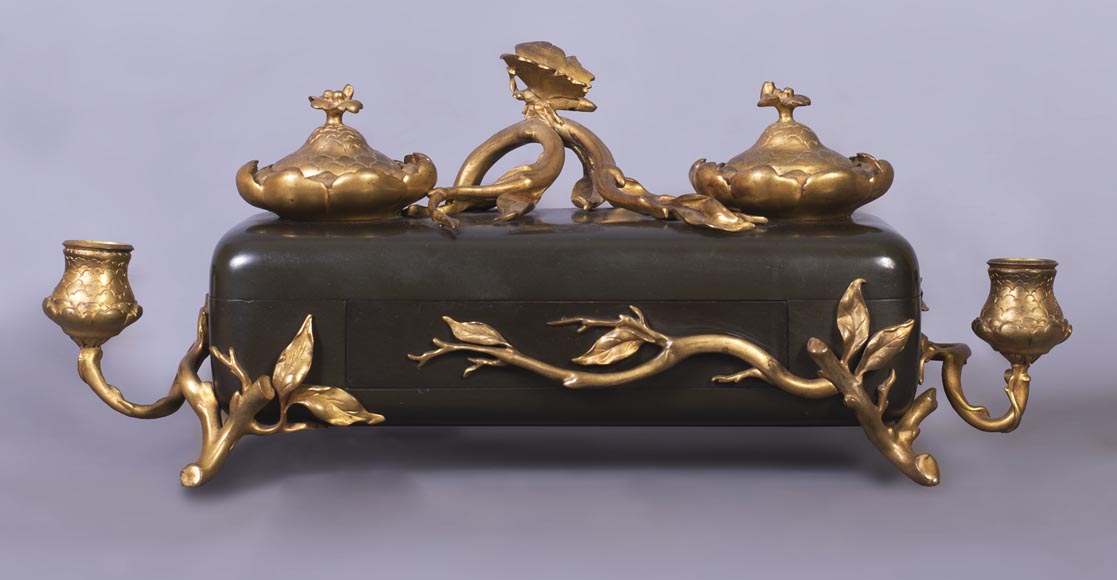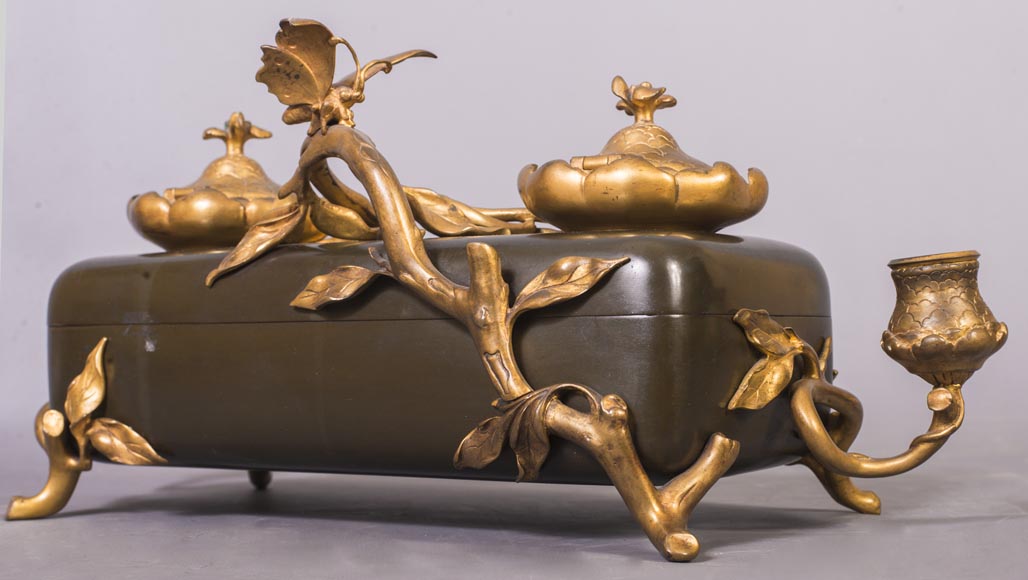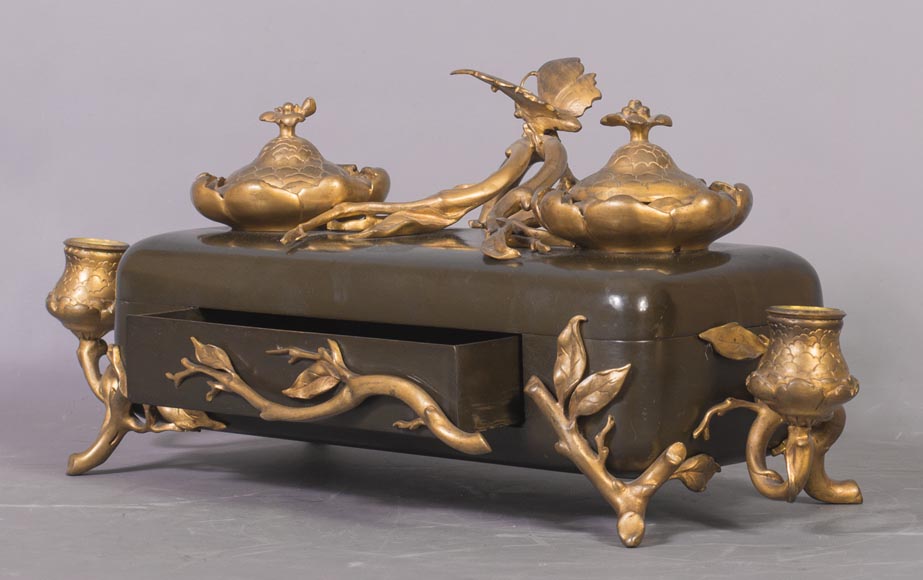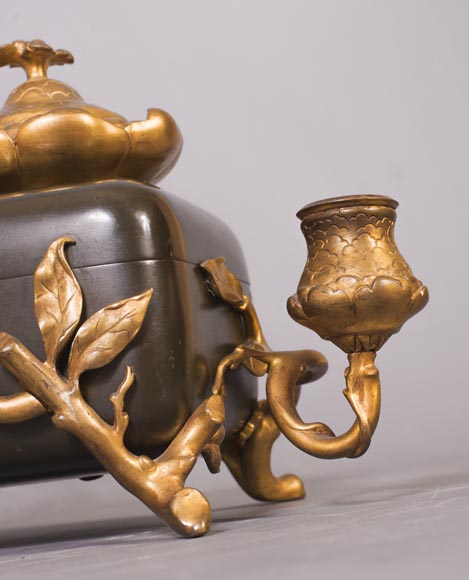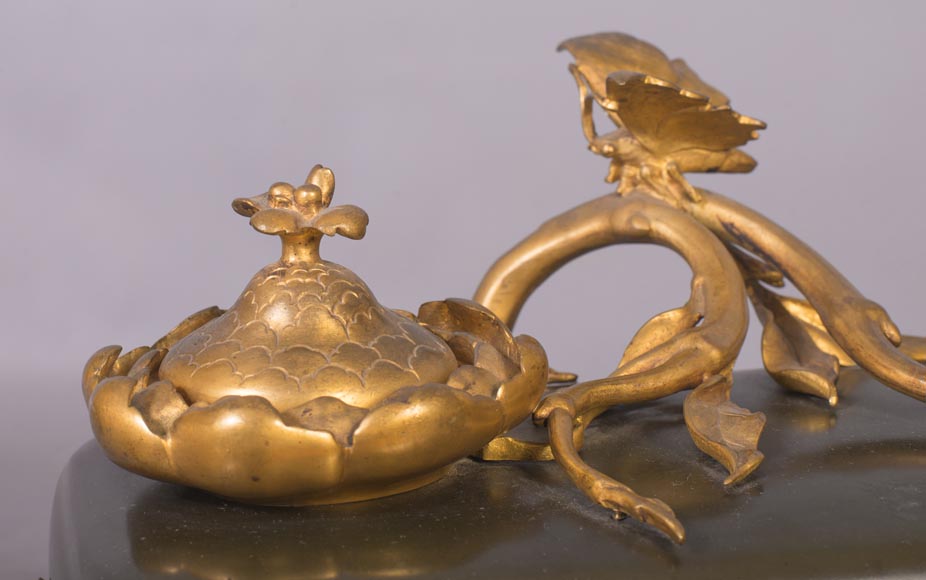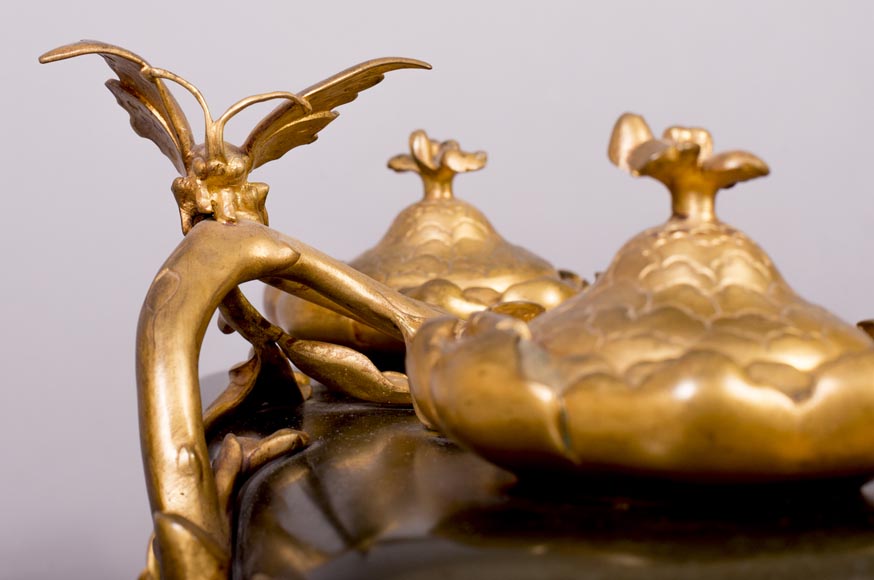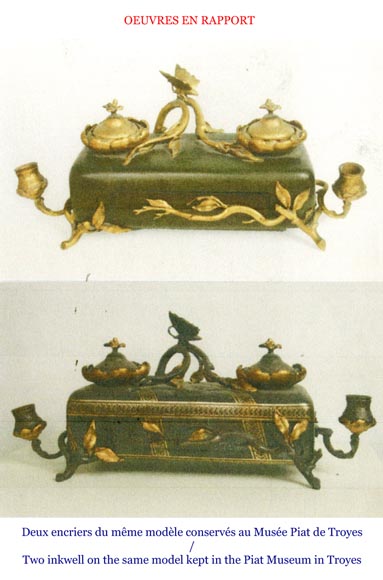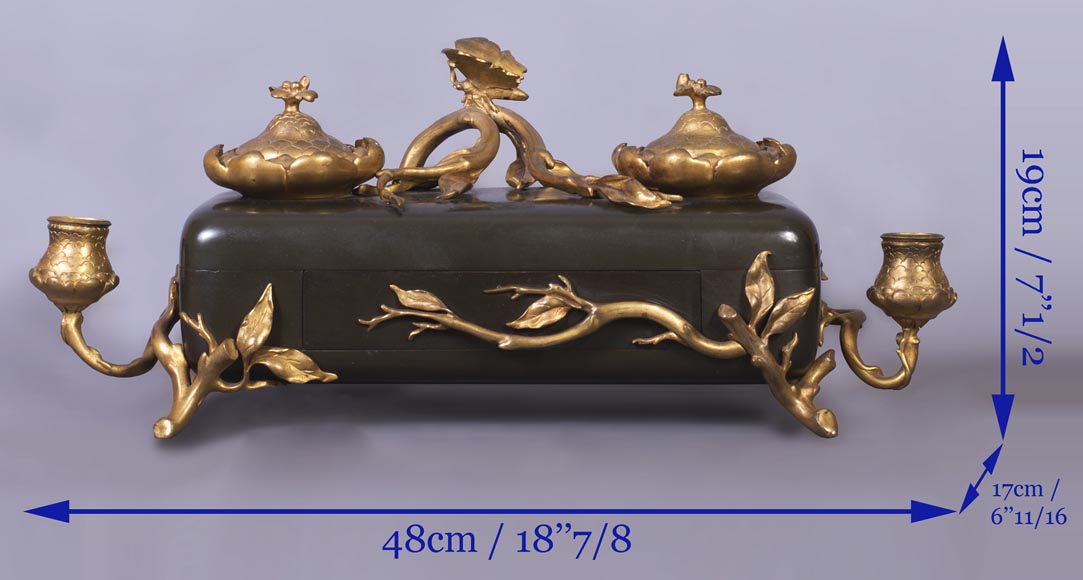Style Japonism, Chinoiserie / Ref.11435
Frédéric-Eugène PIAT (1827-1903) (model by) for Maison PERROT (bronze maker) - Elegant japonese-style inkwell with butterfly
Dimensions
Width 18'' ⅞ 48cm
Height 7'' ½ 19cm
Depth: 6'' ¾ 17cm
Origin:
Paris, circa 1880.
This model of Japanese-style inkwell and candle holder was created by Frédéric-Eugène Piat, sculptor and ornamental designer, for Maison Perrot in Paris, bronze manufacturer. Frédéric-Eugène Piat is famous for the extreme quality of his creations, especially for his works of art models in bronze that were executed by the greatest Parisian bronze makers of his time such as Marchand, Barbedienne, Denière, Boy or, as we have an example here, Maison Perrot.
The Japanese decor on this inkwell is characteristic of the late 19th century, resulting from the discovery of the Far Eastern arts at the World’s Fair of 1867 held in Paris. The opening of Japan to the Western world then allows the creation of a naturalistic-inspired decorative repertoire in which stylized foliages mingle with a world of butterflies and birds.
On this piece, a graceful butterfly, to which the very fine carving of the wings and the body gives an extremely realistic character, thus comes to land on a sinuous branch. This branch forms an elegant connection between the ink tank and that one of sand, which was used before the invention of the blotter to absorb the ink of the paper. These are treated as stylized fruits, whose flowers hatch on the lid's grip. These branches unfold on the base, bringing a great refinement to the composition.
The body of the inkwell is made out of varnished metal of brown color imitating Japanese lacquers.
This work belongs to the series of small objects that Eugène Piat designed for the Maison Perrot et fils, specialized in the production of "small bronzes". The dual use of this object, inkwell and candlestick, marks a real innovation.
The Eugène Piat Museum in Troyes preserves two inkwells of the same model, one much more ornated than the other, which were given by Frédéric-Eugène Piat himself in 1894 at the foundation of the museum. The Catalog of the Troyes Museum, in 1897, describes one of these inkwells:
« The body of this inkwell is in green bronze. It has the appearance of an oblong box, having rounded angles, and entwined with a leafy and blooming stalk. Two blooming flowers (located on the casket) encase the inkwells in their calices; two other flowers placed outside, on the two ends of the casket, are candlesticks, while a section of the stem serves as a handle for the drawer under the inkwells. » (Catalog, Decorative Art, Troyes Museum, 1897, No. 34, page 41).
Born in 1827, Frédéric-Eugène Piat was 6 when his father, a carpenter, moved with his family to Paris. After an apprenticeship with a crew painter, the young Piat helped his father at his furniture factory. He quickly showed a taste and a skill for drawing, which led him to enter, in 1841, apprenticeship with an ornamental designer named Martin, who worked mainly for bronze manufacturers. Frédéric-Eugène Piat was to become one of the most active craftsmen in the new flourishing of French decorative arts. Inventiveness and an extraordinary faculty of creation are his main qualities. In 1843, Piat entered the workshop of a sculptor, Gossin, who had an important terracotta factory. In this workshop, Piat will perfect the control of his gesture, especially in modeling, and, at the end of the year 1845, he begins to execute industrial models alone.
"Served by his reputation, his ease at composition, his already remarkable work power, the young Piat soon got orders. As early as 1849, he composed for the bronze manufacturers Denière, Graux-Marly, Boy, etc., clocks sets or andirons, which were successful. At the age of thirty, Eugène Piat was already famous. Manufacturers were competing for his models. (…)
They were actively looking after Piat's collaboration because his dominant quality was that he knew how to make his models executable. He conceived decorative arrangements perfectly feasible in the material in which they had to be realized. His bronze flares looked like bronze. His wrought-iron andirons had the design that suited this metal. In a word, the artist's imagination complied with the multiple conditions of industrial production and went to the most difficult problems of execution to solve them with remarkable ingenuity. Such a mastery made the part Piat took in the development of the bronze industry all the more valuable. He became the appointed artist of the manufacturers, the one whose collaboration was most highly appreciated, especially when approaching the periods of universal exhibitions. (…)
One of the most prominent bronze makers then was M. Marchand, who, to make a brilliant appearance at the London World's Fair in 1862, contracted the exclusive collaboration of Eugene Piat. The latter immediately began to work and executed, among other pieces, a monumental Neo-Greek fireplace, which may be considered one of his most important works. It was about six meters high and included marbles and polychrome bronzes. A statue of Minerva, in gilded bronze, was placed in the center, standing out against a background decorated with graceful drawings. (...) Unfortunately, this important work is lost. Shipped to a purchaser on a sinking ship, it now rests at the bottom of the sea.
The years that followed were particularly well used. When the World’s Fair of 1867 arrived, it was a real triumph for our artist. Not only with Mr. Marchand, but with several other bronze manufacturers, he had created works in which the litheness and strength of his mature talent were visible. (...) The most brilliant period of the career of Eugene Piat, the one where his talent manifested with the most variety and the most power, is marked by the World’s Fair of 1878. " (Victor Champier in Musée de Troyes, Art décoratif (Musée Piat), Catalogue, 1897).
The collaboration between Piat and Maison Perrot began especially on the occasion of the World’s Fair of 1878 since the major pieces presented by the bronze manufacturer are designed by Frédéric-Eugène Piat. One can easily imagine that it was in this artistically fertile period that this inkwell model was created.
The catalog of the Troyes museum, published in 1897, mentions that the Japanese inkwells preserved there were made by the foundry Aubin and Leroux who exhibited at the World’s Fair of 1889, which is probably also the case for our inkwell.
Informations
Price: on request
Recommended for you :
Dimensions:
Height: 25
Diameter: 12
Dimensions:
Width: 25
Height: 40
Diameter: 50
Dimensions:
Width: 14
Height: 28
Depth: 10
Dimensions:
Width: 38
Height: 15
Depth: 20
Dimensions:
Width: 18
Height: 73
Diameter: 18
Dimensions:
Height: 14
Depth: 17
Dimensions:
Height: 26
Diameter: 11
Dimensions:
Width: 30
Height: 33
Depth: 29
Dimensions:
Width: 13
Height: 23
Depth: 13
Diameter: 13
Dimensions:
Width: 24
Height: 37
Depth: 24
Dimensions:
Width: 15
Height: 38
Depth: 15
Dimensions:
Width: 38
Height: 61
Depth: 23



